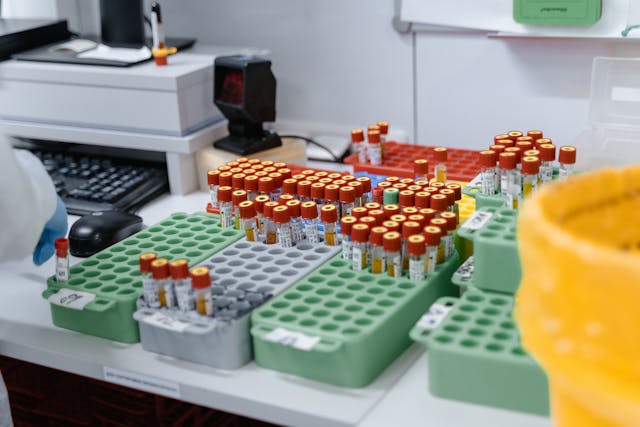
What is leukemia? Leukemia is a type of cancer that begins in the bone marrow. It is a group of different cancers, rather than one type of cancer.
“Leukemia” comes from the Greek words “leukos”, which means white, and “haima”, which means blood. It is named in Greek, but the Greek’s didn’t know what it was. It was named by a pathologist called Rudolf Virchow in 1845. He found a huge number of white blood cells in a blood sample from a victim of the disease and he came up with the name.
Leukemia begins in the bone marrow. What is bone marrow? Bone marrow is soft spongy tissue that is found in the center of some bones. Not all bones have bone marrow but most do. There are two types of bone marrow: red and yellow. They grow in different places and have different functions. Our bones are made up of compact bone, spongy bone, and bone marrow. The compact bone is the hard outer frame of the bone. The spongy bone is found at the ends of bones and is where the red bone marrow is. The yellow bone marrow is found in the center of bones. The red bone marrow contains stem cells that can become red blood cells, white blood cells, or platelets. Yellow bone marrow is made of fat and has stem cells that can become cartilage, fat, or bone cells. The two types of marrow are not actually red and yellow, but the red one has more cells that can make blood so it appears reddish and the yellow one has more fat, so it appears yellowish. Bone marrow is full of nutrients and it is connected to the body’s circulatory system, which is how it gets the blood cells and other cells out. When we are born, we only have red bone marrow, but by the age of seven, about half of it converts into yellow bone marrow. The red bone marrow produces all of the red blood cells we need but, interestingly, if we have an accident and suffer from rapid blood loss, the yellow bone marrow will start to produce red blood cells to try to make up the loss.
So, what is leukemia? There are many different types of leukemia, but they are a type of cancer that starts in the bone marrow. Our bone marrow produces white blood cells when we need to fight infection, but usually, we don’t have that many in our circulation. Leukemia makes the blood marrow produce an enormous number of deformed white blood cells. It happens when one of the stem cells that produces white blood cells mutates. Often mutated cells die and are cleaned out, but in this case, it stays, and it starts to produce more mutated white blood cells. The cell goes haywire and starts to produce these white blood cells like crazy. Each of the new white blood cells has the same mutation. This doesn’t sound like a problem, but it means that the bone marrow cannot make normal red blood cells and platelets because it is too busy producing the mutated white blood cells. This means people with leukemia have a lack of white blood cells, which in turn means they cannot get enough oxygen to their organs. They also don’t produce enough platelets, which means sufferers have trouble forming blood clots if they are injured. And they don’t produce enough normal white blood cells, which means their immune system is compromised. These days, leukemia is far more survivable than it used to be, but if it isn’t treated, it can be fatal because of the inability of the body to fight infections and organ failure. The mutated cells can move to other sites and start growing as tumors as well.
Leukemia can be treated with chemotherapy, to try and kill the mutated cells. There are also two different types of bone marrow transplants that are possible. The first type uses the bone marrow stem cells of the patient. The cells are harvested from the bone marrow through one of several methods, and then frozen. The patient undergoes rigorous chemotherapy that kills all of the bone marrow in the body. Then, when everything is gone, the stem cells are injected into the patient’s blood. The stem cells find their way to the bone marrow site and start to grow. This type of transplant is called an autologous transplant and it is the most favorable because the cells are from the patient’s body, so the immune system doesn’t attack them. The other type of transplant is an allogeneic transplant, which means taking bone marrow from a donor and injecting it into the patient. In this case, just like with an organ transplant, the host body might attack the new cells because they are foreign, and the patient might need to take immunosuppressant drugs. Leukemia is far more survivable now than it used to be, although survival rates tend to go down with age. And this is what I learned today.
https://www.moffitt.org/treatments/blood-bone-marrow-transplant/what-is-bone-marrow
Sources
https://www.mayoclinic.org/diseases-conditions/leukemia/symptoms-causes/syc-20374373
https://en.wikipedia.org/wiki/Leukemia
https://my.clevelandclinic.org/health/diseases/4365-leukemia
https://www.moffitt.org/treatments/blood-bone-marrow-transplant/what-is-bone-marrow
https://en.wikipedia.org/wiki/Bone_marrow
https://www.cancer.gov/publications/dictionaries/cancer-terms/def/bone-marrow
https://my.clevelandclinic.org/health/body/22818-bone-marrow
https://cancer.ca/en/cancer-information/cancer-types/leukemia/what-is-leukemia
https://www.pbmchealth.org/news-events/blog/red-bone-marrow-vs-yellow-bone-marrow
https://www.mayoclinic.org/tests-procedures/bone-marrow-transplant/about/pac-20384854
https://my.clevelandclinic.org/health/diseases/4365-leukemia
https://www.moffitt.org/treatments/blood-bone-marrow-transplant/what-is-bone-marrow

Pingback: #553 How would a cure for cancer work?
Pingback: #127 How does cancer kill people?
Pingback: #561 Are all bones made of calcium?